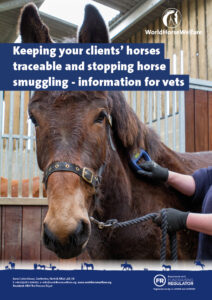It is common for horses to change hands, sometimes multiple times over the course of their lives, highlighting the importance of having a system in place that allows for horses to be fully traceable throughout their lifetime. Current identification regulations require all horses to have a passport and a microchip as means of identification and contain up-to-date details of their registered owner. However, there are flaws with this system which can lead to lack of traceability, fraudulent changes being made to horse details, horse theft and in some cases, horses being smuggled out of the country. Illegal identification documents are surprisingly common and horses may even have more than one microchip. It is important when microchip scanning to scan twice in order to double check that there is only one microchip.
We have pulled together 5 simple steps all horse owners should take to make sure their horses remain visible and protected:
- Make sure your horse is microchipped (a legal requirement) and has a passport with a UK Passport Issuing Organisation (PIO).
- Check your horse’s passport information (e.g., your details and your horse’s description) is up to date and that their microchip number is included in the passport.
- Visit the Central Equine Database (hosted by the Equine Register) and make sure your horse is registered on there.
- Sign up to the Digital Stable (or ScotEquine in Scotland) to create alerts and upload photos should your horse be stolen. These are free services.
- Take photos of your horse regularly, especially of any distinctive markings. Include head shots and photos of the full body from both sides.
The photos you take don’t need to be perfect or staged but should clearly show any distinctive markings as demonstrated by the photos of Bandit below.

Horses can also change colour over time, particularly if they are grey. If you were shown the two pictures of Diamond below, would you believe they were the same horse? Therefore, it is important to take regular photos to document any changes to coat colour.

You may have seen our News story on the Dover 26. These horses were found with fraudulent documentation and were more than likely being smuggled out of the country. This case really highlights the need for proper identification and traceability. You can read more about the progress of the Dover 26 since being in our care here.
To find out more on our work towards improving equine identification and traceability please see our ‘Equine ID and Traceability’ position page.
Keeping your clients’ horses traceable and stopping horse smuggling – information for vets

Traceability guidance for vets, including:
- How to keep your clients horses traceable
- Steps to help prevent horse smuggling
Popular advice in General advice

Horse theft: how to prevent it
Sadly, horse thefts do happen - read our advice on how to keep your horse safe and deter thieves.

Fireworks: keeping your horse safe
Fireworks events can be a worrying time for horse owners. Read our ideas to help you and your horse have a less stressful night.
Other advice categories
All webinar categories:
Call our Advice Line
+44 (0)1953 497 238Not found the advice or answer you were looking for here? Then our Advice Line is available during office hours, or you can email us on education@worldhorsewelfare.org to let us know what topics you were looking for.


